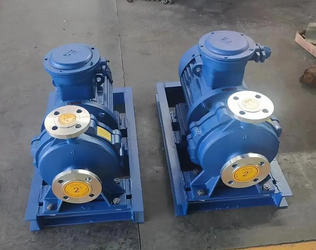General types of chemical pumps
There are many general types of chemical pumps, which can be divided into multiple categories according to different classification standards. The following is a detailed summary of the general types of chemical pumps:
1. Classification by working principle and structure
Vane pump:
This type of pump drives various impeller blades to give centrifugal force or axial force to the liquid when the pump shaft rotates, thereby transporting the liquid. Common vane pumps include centrifugal pumps, vortex pumps, mixed flow pumps and axial flow pumps. Among them, centrifugal pumps can be further divided into single-suction pumps, double-suction pumps, single-stage pumps, multi-stage pumps, volute pumps, segmented pumps, vertical pumps, horizontal pumps, shielded pumps, magnetic drive pumps, high-speed pumps and other types.
Positive displacement pump:
Positive displacement pumps use the continuous change of the volume inside the pump cylinder to transport liquids. This type of pump includes reciprocating pumps (such as electric pumps, diaphragm pumps, metering pumps, etc.) and rotor pumps (such as gear pumps, screw pumps, Roots pumps, vane pumps, etc.).
Other types of pumps:
This type of pump includes jet pumps, air lift pumps, electromagnetic pumps, etc., which realize liquid transportation through different working principles.
2. Classification by main use
Process pumps:
Including feed pumps, reflux pumps, circulation pumps, flushing pumps, sewage pumps, supplementary pumps, output pumps, etc. These pumps play different roles in the chemical production process to ensure the smooth progress of the production process.
Public engineering pumps:
Including boiler pumps, cooling tower pumps, fire pumps, deep well pumps for water sources, etc. These pumps provide necessary support for the public works of chemical enterprises.
Auxiliary pumps:
Including lubricating oil pumps, sealing oil pumps, hydraulic transmission pumps, etc., they play an important role in the lubrication, sealing and transmission systems of chemical equipment.
Pipeline delivery pumps:
Including pumps for oil pipelines, pumps for loading and unloading vehicles, etc. These pumps are mainly used for the transportation and loading and unloading of liquids in pipelines.
3. Classification by conveying medium
Water pumps:
Including clean water pumps, boiler feed pumps, condensate pumps, hot water pumps, etc. These pumps are mainly used to transport water or water-like liquids.
Corrosion-resistant pumps:
Including stainless steel pumps, high silicon cast iron pumps, ceramic acid-resistant pumps, impermeable graphite pumps, hard-lined rubber pumps, hard polyvinyl chloride pumps, etc. These pumps have good corrosion resistance and are suitable for conveying corrosive media.
Impurity pumps:
Including slurry pumps, sand pumps, sewage pumps, coal powder pumps, ash pumps, etc. These pumps can convey liquids containing solid particles or impurities.
Oil pumps:
Including cold oil pumps, hot oil pumps, submersible oil pumps, oil slurry pumps, liquid hydrocarbon pumps, etc. These pumps are mainly used to convey various oil media.
4. Classification by material
Chemical pumps can also be classified according to material, such as stainless steel chemical pumps, fluoroplastic chemical pumps, cast iron chemical pumps, etc. Chemical pumps of different materials have different corrosion resistance and application ranges, and can be selected according to actual needs.





